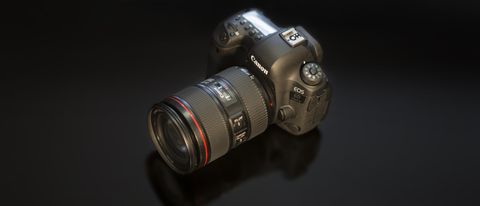Why you can trust TechRadar
Build and handling
- Aluminum alloy and polycarbonate body
- Dust- and moisture-resistant
- Weighs 765g
Like the original EOS 6D, the Canon EOS 6D Mark II is crafted from a mixture of aluminum alloy and polycarbonate with glass fiber, and while it doesn't have quite the same 'pro' feel as the likes of the EOS 5D Mark III or Mark IV, it nonetheless feels very well put together.
It's also nice to see the camera featuring dust and moisture seals – having used the 6D Mark II in some very wet conditions in Norway, with the camera getting drenched on more than one occasion, we can confirm that this camera will more than hold its own when the elements are against you.
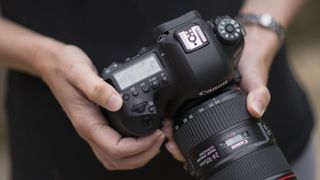
Proportions-wise, the camera is ever so slightly more compact than the EOS 6D – those looking to upgrade from the older model may be a little disappointed to hear that the BG-E13 battery grip designed for the 6D isn't compatible with the EOS 6D Mark II, with a new BG-E21 battery grip accompanying the new camera.
The grip on the body of the 6D Mark II is excellently sculpted, and ensures the camera fits very comfortably in the hand, while the weight of 765g with battery and card in place is just 10g heavier than the original 6D (though it's actually not much lighter than the 800g EOS 5D Mark IV). It also felt very well balanced in the hand when teamed with the EF 24-105mm f/4L IS II USM we shot with.
As for the layout of buttons and controls, if you're coming from the EOS 6D you should feel right at home with the EOS 6D Mark II, as the control layout on the two cameras is pretty much identical.
There's a large LCD display on the top plate with plenty of information on tap, while there are controls for the AF, drive, ISO and metering between the LCD and the front command dial. The only new addition is a small button next to the command dial that affords access to the camera's focusing modes to complement the 6D Mark II's more sophisticated AF system.
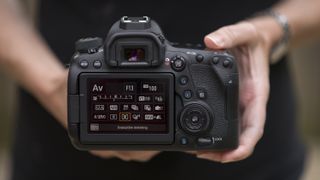
Sticking with the same control layout as the EOS 6D means the EOS 6D Mark II forgoes a joypad on the rear of the camera to quickly move the AF point, as we've seen on some other EOS DSLRs; instead you use the multi-directional controller to do this. While it would have been nice to see this extra control incorporated into the camera, AF point selection is still pretty quick to achieve using this method.
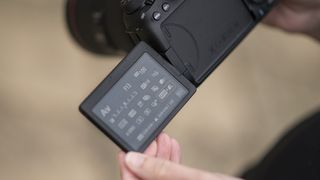
That just leaves the rear display, which as we've mentioned can now be angled away from the body to suit a plethora of shooting angles. While its resolution doesn't get a boost over the display on the EOS 6D, the 1,040,000-dot screen looks decent enough, while the touch interface on the EOS 6D Mark II is one of the best around – from adjusting settings to flicking through images, it works a treat.

Autofocus
- 45-point AF, all cross-type
- Sensitive down to -3EV
- Dual Pixel CMOS AF system
The 11-point AF system on the original EOS 6D looked out of date even when that camera was launched, and it came in for a bit of stick – particularly as only the central point sported a cross-type sensor. So it's no surprise to see the EOS 6D Mark II get a hefty bump in AF coverage.
Rather than borrowing the 61-point AF system from the EOS 5D Mark IV, the 6D Mark II looks to its APS-C stablemates and employs a 45-point AF system that's very similar to the one inside the recent EOS 80D and EOS Rebel T7i / 800D.
And the good news is that rather than featuring one lone cross-type point (cross-type points are sensitive in both the horizontal and vertical planes for greater accuracy), all 45 points are cross-type, with the central point being dual cross-type, featuring a second point oriented at 45 degrees to the regular point for even greater precision. Furthermore, 27 of these remain operational when using a lens, or lens/teleconverter combination, with a maximum effective aperture of f/8, with nine remaining cross-type.
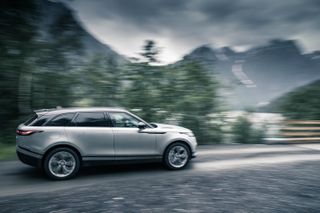
The EOS 6D Mark II offers a decent amount of control over customizing the AF setup too, with some 16 options to tweak should you wish. However, there are no AF 'case studies' (which specify the tracking sensitivity, acceleration and deceleration tracking and AF point switching depending on the subject you're shooting) as we've seen on the likes of the EOS 7D Mark II and EOS 5D Mark IV.
Coverage of the 45 AF points is quite heavily weighted towards the central portion of the frame, meaning you'll have to regularly recompose shots if your subject is off-centre.
That aside, AF performance is very good. We shot under a variety of lighting conditions on our trip to Norway and found focusing to be very good, with subjects acquired swiftly and accurately in most instances. Even in poor light the EOS 6D Mark II didn't really struggle – thanks in part, no doubt, to the camera's AF system being sensitive down to -3EV.
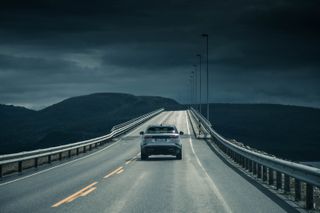
The EOS 6D Mark II also gets Canon's impressive Dual Pixel CMOS AF for Live View photography and video capture. It's a big improvement over the EOS 6D's rather clunky system, delivering smooth and fast focusing, especially when used in tandem with the touchscreen to select your desired point of focus.
Current page: Build, handling and AF
Prev Page Introduction and key features Next Page Performance and image qualityPhil Hall is an experienced writer and editor having worked on some of the largest photography magazines in the UK, and now edit the photography channel of TechRadar, the UK's biggest tech website and one of the largest in the world. He has also worked on numerous commercial projects, including working with manufacturers like Nikon and Fujifilm on bespoke printed and online camera guides, as well as writing technique blogs and copy for the John Lewis Technology guide.
